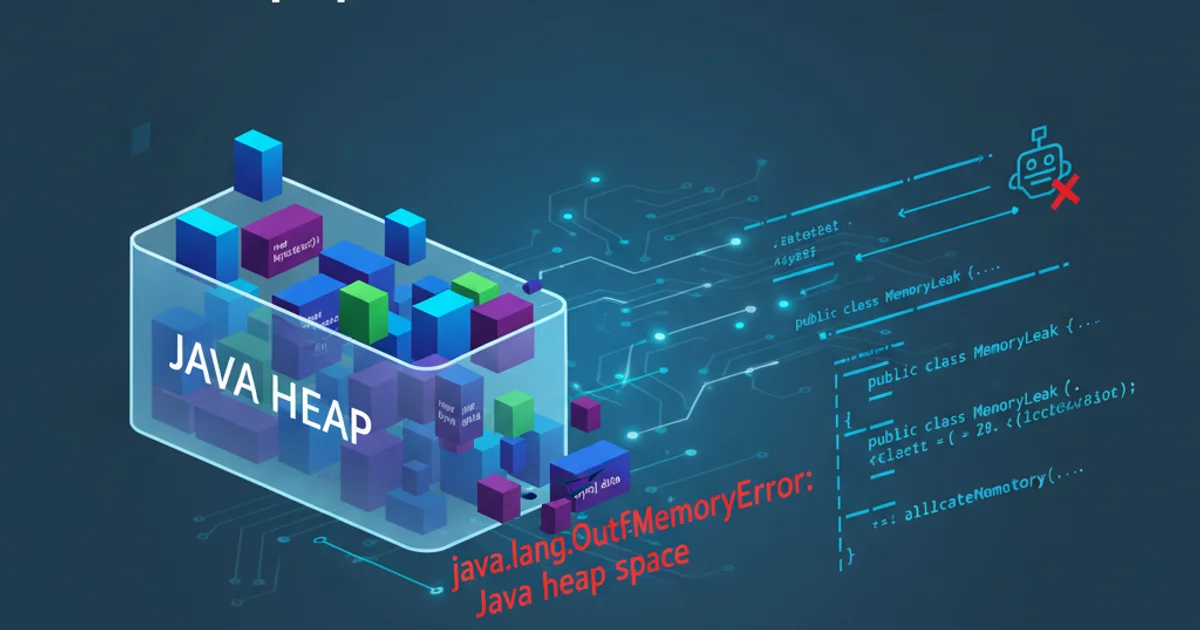How to deal with "java.lang.OutOfMemoryError: Java heap space" error?
Categories:
Demystifying and Resolving 'java.lang.OutOfMemoryError: Java heap space'

Understand the root causes of Java heap space OutOfMemoryError and learn practical strategies to diagnose, prevent, and resolve this common JVM issue for robust application performance.
The java.lang.OutOfMemoryError: Java heap space is one of the most common and frustrating errors encountered by Java developers. It signifies that the Java Virtual Machine (JVM) has run out of memory in the heap, which is the region of memory where objects are allocated. This error doesn't necessarily mean there's a memory leak, but rather that the application is attempting to allocate more memory than the JVM has been configured to provide, or that there's an accumulation of objects that are no longer needed but haven't been garbage collected.
Understanding the Java Heap Space
The Java heap is a crucial part of the JVM's runtime data area. It's where all class instances and array objects are stored. The heap is divided into different generations (Young, Old/Tenured, and sometimes Permanent/Metaspace) to optimize garbage collection. When an application tries to create a new object, and there isn't enough contiguous free space in the heap to accommodate it, the OutOfMemoryError is thrown. This can be due to several reasons, including an undersized heap, inefficient code, or actual memory leaks.
flowchart TD
A[Application requests new object]
B{Is there enough free heap space?}
C[Allocate object]
D[JVM attempts Garbage Collection]
E{Is there enough free heap space after GC?}
F["java.lang.OutOfMemoryError: Java heap space"]
A --> B
B -- Yes --> C
B -- No --> D
D --> E
E -- Yes --> C
E -- No --> FFlowchart of Java Heap Allocation and OutOfMemoryError Trigger
Diagnosing the OutOfMemoryError
Effective diagnosis is the first step to resolving OutOfMemoryError. The JVM provides several tools and options to help understand memory usage patterns and identify the root cause. Analyzing heap dumps and garbage collection logs are critical for pinpointing problematic areas in your application's memory footprint.
OutOfMemoryError doesn't occur.java -Xlog:gc*:<file-path> -jar YourApplication.jar
Enabling comprehensive GC logging for a Java application
Heap dumps are snapshots of the JVM's memory at a specific point in time, showing all objects, their values, and references. They are indispensable for identifying memory leaks or unexpectedly large object graphs. You can configure the JVM to automatically generate a heap dump upon an OutOfMemoryError.
java -XX:+HeapDumpOnOutOfMemoryError -XX:HeapDumpPath=/path/to/dumps/ -jar YourApplication.jar
Configuring JVM to generate a heap dump on OutOfMemoryError
Resolving and Preventing Heap Space Issues
Once diagnosed, resolution often involves a combination of increasing heap size, optimizing code for memory efficiency, and fixing actual memory leaks. Prevention is key, and it starts with good coding practices and thorough testing.
1. Adjust JVM Heap Size
The simplest, though not always the best, solution is to increase the maximum heap size using the -Xmx JVM argument. This provides more memory for your application. For example, -Xmx4g sets the maximum heap size to 4 gigabytes. Ensure you don't set it too high, as it can lead to excessive garbage collection pauses or even swap space usage, degrading performance.
2. Analyze Heap Dumps
Use tools like Eclipse Memory Analyzer (MAT) or VisualVM to analyze heap dumps. Look for large objects, collections holding onto many elements, or objects that are unexpectedly retained. These tools can help identify memory leaks where objects are no longer needed but are still referenced, preventing garbage collection.
3. Optimize Code for Memory Efficiency
Review your code for inefficient memory usage. This includes:
- Using appropriate data structures (e.g.,
ArrayListvs.LinkedList,HashMapvs.TreeMap). - Avoiding creation of unnecessary objects, especially in loops.
- Nullifying references to large objects when they are no longer needed, especially in long-running processes or static contexts.
- Closing resources (streams, connections) properly to prevent resource leaks that can indirectly lead to memory issues.
4. Monitor Garbage Collection
Regularly monitor GC logs and metrics. High GC activity or long GC pauses can indicate memory pressure. Tuning GC algorithms and parameters (e.g., -XX:NewRatio, -XX:+UseG1GC) can sometimes alleviate heap issues, though it's often a symptom rather than the root cause.
-Xmx) should be a temporary fix or a last resort if other optimizations fail. A continuously growing heap requirement often points to a memory leak or inefficient design that needs addressing.